
Jung Bahadur Kunwar Ranaji, belonging to the Kunwar family was a Khas Chhetri ruler of Nepal and founder of the Rana Regime in Nepal. Jung Bahadur took control of the government after killing an alleged usurper Gagan Singh, who was accused of plotting with the junior queen in 1846 to become prime minister by putting the queen's son on the throne. His original name was Bir Narsingh Kunwar but he was popularly known as Jang Bahadur, a name given to him by his maternal uncle Mathabar Singh Thapa. Mathabar Singh Thapa used to call Jang Bahadur Jangay for his boldness.
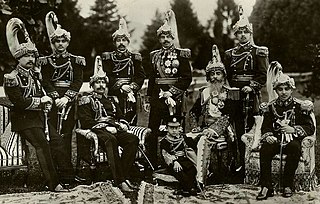
The Rana dynasty was a Chhetri dynasty that imposed totalitarianism in the Kingdom of Nepal from 1846 until 1951, reducing the Shah monarch to a figurehead and making the Prime Minister and other government positions held by the Ranas hereditary. They are Kshatriya, whose ancestor descended from the Ranas of Udaipur, Rajasthan. Rana dynasty is historically known for the iron-fisted rule. This changed after the Revolution of 1951 with the promulgation of a new constitution, when power shifted back to the monarchy of King Tribhuvan.
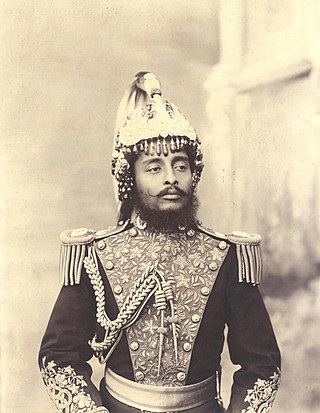
Field-Marshal Maharaja Sri Teen Chandra Shumsher Jung Bahadur Rana was the Prime Minister of Nepal from the Rana dynasty. He served in this capacity from 27 June 1901 to his death in 1929 after he successfully deposed his liberal and reformist brother Dev Shamsher. Although generally perceived as despotic and conservative, he is credited with several reforms including the abolition of slavery and establishing the Nepal-Britain Treaty of 1923, which recognised Nepal as an independent nation and an ally of Britain.
Commander in Chief Kiran Shamsher Jang Bahadur Rana (1916–1983) was a Nepalese army officer. He served as the Royal Nepalese Army's Commander-in-Chief from 1951–1956 and as the Nepalese ambassador to the United Kingdom from 1973–1977. Over the course of thirty years, he served as Aide-de-camp General to King Tribhuvan, King Mahendra and King Birendra.
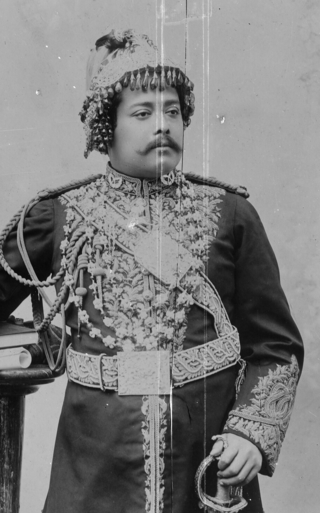
Sri Maharaja, Dev Shumsher Jung Bahadur Rana was the Prime Minister of Nepal for 114 days in 1901. He was also the King of Lamjung and Kaski.
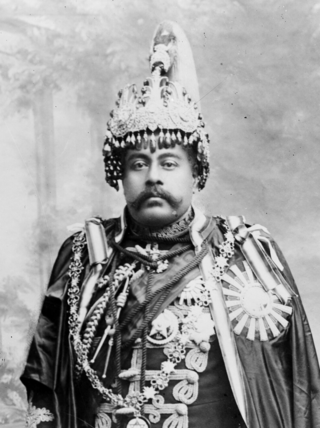
Field Marshal Shree Shree Shree Maharaja Sir Juddha Shumsher Jung Bahadur Rana was the Prime Minister of Nepal from 1 September 1932 to 29 November 1945 as the head of the Rana dynasty.
Nir Shumsher Jung Bahadur Rana. Field Marshal and retired General of the Nepal Army (NA). Born on 11 Poush, 1970 B.S. (1913) in Jawalakhel Durbar, Jawalakhel, Lalitpur, Field Marshal Rana died at the age of 99. He was son of the then ruling Rana Prime Minister Juddha Shumsher Rana and his second wife, Mahila Maharani Krishna Kumari. According to a statement, the centenarian Field Marshal had joined the then Royal Nepal Army (RNA) at the age of 18 on 1 Shrawan 1988 B.S (1931) and was appointed to the post of Major at the Shri Pashupati Prasad Battalion. He became the Commander-in-Chief of the RNA on 15 Baisakh, 2017 B.S (1960) and retired on 15 Baisakh in 2022 B.S (1965). He was appointed Field Marshal after his retirement in 2022 B.S.

Thapathali Durbar was a palace complex in Kathmandu, the capital of Nepal. Thapathali means abode of the Thapas. It was initially built by Nain Singh Thapa of the Thapa dynasty but was later occupied by Jung Bahadur Rana, as prime minister, the executive head of Nepal. The palace complex, located north of the Bagmati river, encompasses an impressive and vast array of courtyards, gardens, and buildings. Many palaces and buildings were built throughout late 1840s to 1900, initially by Nain Singh Thapa, a member of the aristocratic Thapa family and brother of Bhimsen Thapa, and later was acquired by Nain Singh Thapa's grandson Jung Bahadur Rana. Further additions were made by successive Ranas up to the 19th century.

Babar Mahal, Baber Mahal is a Rana palace in Kathmandu, the capital of Nepal. The palace complex, located north of the Bagmati river, was incorporated in an impressive and vast array of courtyards, gardens and buildings. Initially the palace was under Jung Bahadur Rana's Thapathali Durbar but later was separated and demolished and rebuilt by Chandra Shumsher Jang Bahadur Rana, as prime minister and the executive leader of Nepal.
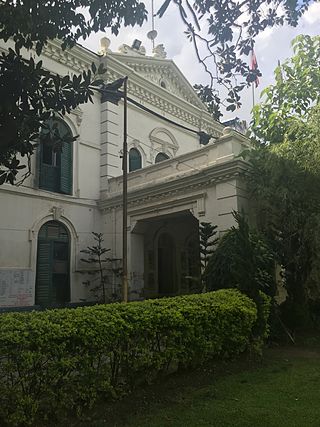
Bag Durbar, is a palace built and resided by Thapa regime in Kathmandu, the capital of Nepal. The palace complex, located west of the Dharahara and Tundikhel, incorporates an impressive and vast array of courtyards, gardens and buildings. Initially the palace was owned by Amar Singh Thapa (Sardar) of Thapa regime and his descendant but later was occupied by Royals of Shah dynasty, and later by government of Nepal.

Lal Durbar is a Rana palace in Kathmandu, the capital of Nepal. The palace complex, located East of the Narayanhity Palace, was incorporated in an impressive and vast array of courtyards, gardens and buildings. Lal Durbar was built by Bir Shamsher JBR in 1890 CE.

Seto Durbar was a Rana palace in Kathmandu, the capital of Nepal. The palace complex, located south of the Narayanhity Palace, was incorporated in an impressive and vast array of courtyards, furnishings and guest halls. Seto Durbar was built by Bir Shumsher Jung Bahadur Rana in 1893 CE.
Jaulakhel Durbar was a Rana palace in Jawalakhel, Lalitpur, the capital city of Nepal. Jaulakhel Durbar was built by Bir Shumsher Jang Bahadur Rana in 1954 BS.

Crown Prince Trailokya was, as the eldest son of King Surendra of Nepal, the heir apparent to the throne of Nepal. He died under suspicious circumstances before his father, paving the way for his young son Prithvi to ascend the throne.

Dhir Shumsher Kunwar after 1848 known as Dhir Shumsher Kunwar Ranaji or Dhir Shumsher Jang Kunwar Ranaji or shortly Dhir Shumsher Rana posthumously known as Dhir Shumsher Jang Bahadur Rana was a Nepalese politician, army general and minister of state. He served as the Commander-In-Chief of the Nepalese Army from 1879 to 1884 A.D. He was born in Kunwar family as the youngest son of Kaji Bal Narsingh Kunwar and Ganesh Kumari Thapa, daughter of Kaji Nain Singh Thapa of Thapa dynasty. Dhir Shumsher was the youngest brother of Jang Bahadur Kunwar Ranaji, who rose to premiership of Nepal after the murders of influential persons - Mathabarsingh Thapa and Gagan Singh Bhandari and the incidence of Kot Massacre. Dhir was personally involved in the massacre protecting his nearly slaughtered brother Krishna Bahadur Kunwar Rana. Dhir became military Colonel after the incident. He was in the entourage of Jung Bahadur's visit of Europe in the early 1850s.
Krishna Bahadur Kunwar after 1848 CE known as, Krishna Bahadur Kunwar Rana was the Nepalese politician, administrator, military general and minister of state. He served as the acting Prime Minister of Nepal upon the demise of his elder brother Bam Bahadur Kunwar from 25 May 1857 to 28 June 1857. He also served as the Commander-In-Chief of the Nepalese Army between 1857 and 1862.

Jagat Jung Kunwar Rana, popularly known as Jagat Jung Rana was a Nepalese politician, military officer and courtier in the Kingdom of Nepal. He was the eldest son of the founder of Rana dynasty, Jung Bahadur Kunwar Rana. He claimed the Premiership of Kingdom of Nepal and the throne of Maharaja of Lamjung and Kaski against the traditional agnatic succession of the Rana dynasty. Driven by this motive, he attempted a coup against his uncles; Maharaja Prime Minister Ranodip Singh Kunwar and Commander-In-Chief Dhir Shamsher Kunwar Rana in the winter of 1881–1882. He was immediately thrown out of the roles of succession among Ranas. Later, he was pardoned and was impeased by Ranodip Singh as his successor after the death of Dhir Shamsher, which caused envy among his Shamsher cousins and ultimately led to his death in the 1885 Shamsher coup.

Hari Priya Devi was a Nepalese Bada Maharani who was active in the Nepal Durbar politics. She was the second wife of Ranodip Singh Kunwar, the second prime minister of Nepal from the Rana dynasty.
Dambar Shumsher Rana was a Nepalese general.
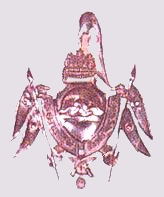
Lamjung and Kaski was a state which was given to His Highness Shree Tin Maharaja Jung Bahadur Rana in 1856 by His Majesty King Surendra Bir Bikram Shah.















